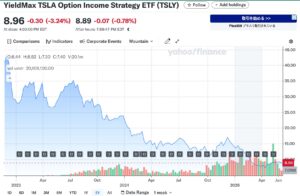Understanding TSLY & Its Performance in Two Investment Scenarios
This analysis evaluates two distinct investment strategies for TSLY (YieldMax TSLA Option Income Strategy ETF). We compare their performance from early June 2024 to the end of May 2025. Your provided historical data forms the basis of this assessment.
What is TSLY? (TSLY Explained)
TSLY, ticker symbol for the YieldMax TSLA Option Income Strategy ETF, is a specialized exchange-traded fund. Its primary goal is to provide high monthly income to investors. This income is generated primarily through a covered call strategy on Tesla (TSLA) stock.
TSLY does not directly track Tesla’s stock price. Instead, it holds Tesla shares while simultaneously selling call options on them. This generates premium income. This premium constitutes the core of its monthly distributions.
Key characteristics of TSLY include:
- Income Focus: Its main objective is consistent, high monthly payouts.
- Covered Call Strategy: It uses options selling to generate income.
- Relationship to TSLA: Its performance is linked to Tesla. However, it offers limited upside capture. If TSLA stock significantly rises, TSLY’s potential gains are capped.
- Risk/Reward Trade-offs: While aiming for high income, TSLY can experience capital depreciation. Investors face the risk of principal loss. This is especially true if the underlying TSLA stock declines sharply.
TSLY Investment Strategy Comparison: A $10,000 Portfolio Analysis
This section details the comparative performance of your two investment approaches using TSLY.
Key TSLY Data Utilized:
- Initial Purchase Price (Early June 2024): The closing price on June 3, 2024, was $14.78.
- Evaluation Price (End of May 2025): The closing price on May 26, 2025, was $9.18.
- Total Dividend Per Share (June 2024 – May 2025): During this period, TSLY paid a total of $10.855 pe
- r share in dividends.
1. Scenario 1: $10,000 Lump-Sum Investment
This strategy involved committing the entire $10,000 upfront. The investment took place on June 3, 2024.
- Investment Amount: $10,000
- Purchase Price: $14.78 per share
- Shares Acquired: Approximately 676.58 shares ($10,000 / $14.78)
Performance as of May 2025 End:
- Total Dividends Received: $7,344.20 (676.58 shares * $10.855/share)
- Current Share Value: $6,211.20 (676.58 shares * $9.18/share)
- Total Investment Return (Including Dividends): ($6,211.20 + $7,344.20) – $10,000 = $3,555.40 Gain
- Return on Investment (ROI): +35.55%
2. Scenario 2: Weekly 100-Share Purchase (Within $10,000 Budget)
This strategy involved purchasing 100 shares weekly. The strategy continued until the $10,000 budget was fully utilized. It commenced in early June 2024.
- Purchase Period: From early June 2024 until the budget was exhausted.
- Shares Acquired: Within the $10,000 limit, a total of 640 shares were acquired.
- Total Investment Cost: $9,987 (This cost was incurred over several weeks, completing by July 12, 2024).
Performance as of May 2025 End:
- Total Dividends Received: $6,947.20 (640 shares * $10.855/share)
- Current Share Value: $5,875.20 (640 shares * $9.18/share)
- Total Investment Return (Including Dividends): ($5,875.20 + $6,947.20) – $9,987 = $2,835.40 Gain
- Return on Investment (ROI): +28.39%
Comprehensive Comparison & Analysis
Let’s present a side-by-side comparison of the two strategies’ outcomes.
Key Insights:
- Share Price Trend: TSLY’s share price experienced a significant decline. It dropped from $14.78 in June 2024 to $9.18 by May 2025. This represents a substantial capital depreciation.
- Power of Dividends: Despite this capital depreciation, both strategies yielded positive returns. This underscores the critical role of TSLY’s high dividend payouts. These dividends effectively offset the capital losses. They transformed a potential negative return into overall profitability.
- Lump-Sum Outperformance (in this specific scenario): In this particular period, the lump-sum investment strategy generated higher total returns and a superior ROI.
- This advantage stems from the initial purchase price ($14.78). This price point in early June 2024 was relatively favorable.
- The lump-sum approach acquired more shares (676.58 shares) with the $10,000 budget. This occurred entirely at that advantageous initial price.
- The weekly purchase strategy, while disciplined, continued buying through subsequent periods. These periods might have seen higher average prices. This resulted in fewer shares acquired within the same budget limit.
- Strategy Implications: TSLY is characterized by high yield and significant price volatility. Understanding the interplay between initial entry point, consistent dividend income, and capital appreciation or depreciation is crucial. In this scenario, committing capital early during a relatively low price period proved more beneficial. It allowed the investor to capitalize on the subsequent dividend streams more effectively.
Conclusion:
Both investment strategies for TSLY proved profitable during this timeframe. This success was predominantly driven by the substantial dividend income. However, the lump-sum investment made in early June 2024 demonstrated better performance. It secured a larger number of shares at an advantageous initial price. This led to a higher total profit by the end of May 2025. This case highlights how timing the market entry, even with a high-yield, volatile asset, can significantly impact overall returns.
Disclaimer: This content is for informational purposes only. It does not constitute financial advice. Investment decisions should be made with a qualified financial advisor. Past performance is not indicative of future results. Market conditions can change rapidly.

Interesting!!